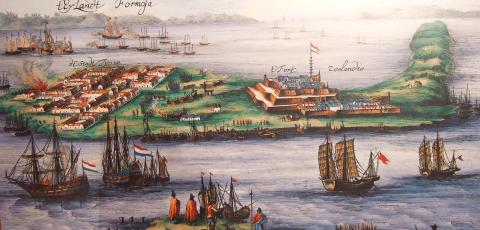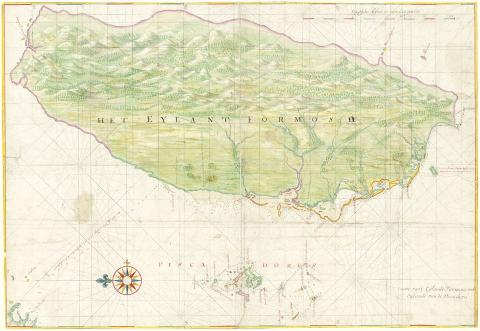During the past three decades, the perception of Taiwan’s history has undergone a significant change. In the traditional perspective, Taiwan and its history were closely linked to China, particularly its coastal province of Fujian, from where the majority of the population migrated in the 17th and 18th centuries.
This linkage with China was reinforced after 1949 during the period of rule by the Chinese Nationalist Party (KMT) who wanted to strengthen their perception that Taiwan had historically been an integral part of China. In high schools and universities, children were taught Chinese history and geography, while the KMT authorities neglected, or even suppressed, Taiwan’s history.
This started to change after the nation’s momentous transition to democracy in the late 1980s and early 1990s, when presidents Lee Teng-hui (李登輝) and Chen Shui-bian (陳水扁) initiated educational reforms that included history and geography of Taiwan in the curriculum. In 2015 there was an effort by the Ma Ying-jeou (馬英九) administration to return to a Sino-centric perspective, but this ran into strong opposition from high school students who went into the streets to block Ma’s moves.

Photo courtesy of Wikimedia Commons
TAIWAN at the center of its HISTORY
So, what is new in the history of Taiwan as we see it now, and how is this different from the previous perspective? There are three aspects. First, the close connection between Taiwan’s Aboriginal population and the original people of the Pacific islands, including New Zealand and Hawaii, going back more than 3,000 years.
Secondly, the fact that during the period of Dutch colonial rule (1624-1662), Taiwan — and in particular the harbor of Tayouan (Anping District (安平) in present-day Tainan) — was a major and prosperous international trading post, linking Taiwan to Japan, Southeast Asia, and as far as India and Persia. Taiwan was “connected to the world” in that first phase of globalization.

Photo courtesy of Wikimedia Commons
Thirdly, it wasn’t until the rule of Koxinga (Cheng Cheng-kung, 鄭成功), the Ming-dynasty warlord and pirate chieftain, that Taiwan — for the first time in its history — became more closely connected with the Chinese coastal provinces. Prior to the Dutch era there had been scant interaction with the coastal provinces.
‘THE GREAT MIGRATION’
During the past three decades, linguistic and DNA research has presented evidence that Taiwan was the main source of “The Great Migration,” starting around 3,000 BC, which eventually populated almost all of the Pacific. This research placed Taiwan’s indigenous people to be at the origin of almost all original inhabitants of the Pacific archipelagos such as Micronesia, Polynesia and Melanesia.
In addition, archaeological work in Taiwan and elsewhere in Asia has shown the existence of extensive trading networks between Taiwan and Southeast Asia as early as 2,800 BC to 2,200 BC. Taiwan’s early connections to the Pacific and Southeast Asia are thus well established, and are the basis for seeing Taiwan as an “Ocean nation.”
DUTCH RULE
Much more has become known about the period of Dutch colonial rule of Taiwan in the 17th Century. In the mid-1980s, a team of researchers headed by Leonard Blusse of Leiden University started to publish the official records of the Dutch East India Company’s reports by the Dutch governors and local officials at Fort Zeelandia (in today’s Tainan), the headquarters of the “Vereenigde OostIndische Compagnie” (VOC, Dutch East India Company) in Formosa (Taiwan) from 1624 to 1662.
These reports provided a whole new generation of researchers with ample material on the interactions between the Dutch and the Aboriginal population, as well as the Hokkien immigrants who started to migrate from the coastal province of Fujian during the Dutch period. The research was initiated in the 1960s and 1970s by Tsao Yung-ho (曹永和), a librarian at the National Taiwan University Library, but didn’t become mainstream until the 1990s.
This newly available material led to a new wave of publications between the early 2000s and the present. Much of this focused on the 17th-century interaction between the Dutch and both the indigenous people as well as the Hokkien immigrants, as well as the struggle for power between the Dutch and Ming Dynasty warlord Koxinga who himself was on the run from the Qing Dynasty, which had come to power in 1644.
PROTO GLOBAL ECONOMY
There is however a fourth aspect which does deserve more attention in academic research, and in how the Dutch period is perceived in the context of Taiwan’s history: Taiwan’s connection with, and integration in, the world economy in the 17th Century.
Taiwan itself became the source of a number of important trading goods, initially deer hides. Aboriginal hunters would hunt the deer, sell the hides to Dutch traders who would sell them in Japan to Samurai warriors who prided the tough deerskins for their armor and shields. However, over-hunting gradually depleted the deer-stock and the trade diminished after 1650.
But from 1635 onward, the Hokkien settlers started to produce rice and sugar, which in the 1640s and 1650s became major export products, shipped by the Dutch to as far away as Japan, India and Persia.
This major increase in trade between Taiwan and the rest of the world was accompanied by increasing interest elsewhere in Taiwan: writers and mapmakers literally started to “put Taiwan on the map.” The National Palace Museum in Taipei did a major exhibition on this topic in 2003: The Emergence of Taiwan on the World Scene in the 17th Century.
NEW FRONTIER
However, subsequent events would significantly reduce this high connectivity between Taiwan and the rest of the world. As described earlier, Koxinga was driven into a corner by the invading Qing/Manchu Dynasty, and in 1661 crossed over to Taiwan, driving out the Dutch after a nine-month siege of Fort Zeelandia.
During the 1662-1683 reign of Koxinga’s successors (he himself died four months after his victory over the Dutch), many more immigrants from the coastal provinces came to Taiwan to escape war and hunger and start a new life at the new frontier. At the end of the period, there were some 100,000 Hokkien immigrants, and interaction with the Fujian homeland became the main focus of Taiwan’s economic life.
This only intensified after 1683, when Koxinga’s successors were defeated by Qing Dynasty troops under Qing Admiral Shih Lang (施琅), who eventually convinced Qing Emperor Kangxi (康熙帝) to agree to the conquest of Taiwan, but who himself was eyeing rich farmlands around Tainan. During the subsequent 200 years, trade and the movement of people were primarily focused on China’s coastal provinces, thus narrowing its interactions and exchanges with the outside world.
This international isolation only ended in the latter half of the 19th Century, when the event of steamships made long-distance travel easier, and Taiwan again became the focus of international attention. This eventually led to the formal transfer of the sovereignty over the island under the 1895 Treaty of Shimonoseki, when the Qing government in Beijing ceded Taiwan to Japan, without consulting the island’s population.
Gerrit van der Wees is a former Dutch diplomat who also served as editor of ‘Taiwan Communique,’ a publication in Washington DC. He currently teaches history of Taiwan at George Mason University.

April 14 to April 20 In March 1947, Sising Katadrepan urged the government to drop the “high mountain people” (高山族) designation for Indigenous Taiwanese and refer to them as “Taiwan people” (台灣族). He considered the term derogatory, arguing that it made them sound like animals. The Taiwan Provincial Government agreed to stop using the term, stating that Indigenous Taiwanese suffered all sorts of discrimination and oppression under the Japanese and were forced to live in the mountains as outsiders to society. Now, under the new regime, they would be seen as equals, thus they should be henceforth

Last week, the the National Immigration Agency (NIA) told the legislature that more than 10,000 naturalized Taiwanese citizens from the People’s Republic of China (PRC) risked having their citizenship revoked if they failed to provide proof that they had renounced their Chinese household registration within the next three months. Renunciation is required under the Act Governing Relations Between the People of the Taiwan Area and the Mainland Area (臺灣地區與大陸地區人民關係條例), as amended in 2004, though it was only a legal requirement after 2000. Prior to that, it had been only an administrative requirement since the Nationality Act (國籍法) was established in

With over 80 works on display, this is Louise Bourgeois’ first solo show in Taiwan. Visitors are invited to traverse her world of love and hate, vengeance and acceptance, trauma and reconciliation. Dominating the entrance, the nine-foot-tall Crouching Spider (2003) greets visitors. The creature looms behind the glass facade, symbolic protector and gatekeeper to the intimate journey ahead. Bourgeois, best known for her giant spider sculptures, is one of the most influential artist of the twentieth century. Blending vulnerability and defiance through themes of sexuality, trauma and identity, her work reshaped the landscape of contemporary art with fearless honesty. “People are influenced by

The remains of this Japanese-era trail designed to protect the camphor industry make for a scenic day-hike, a fascinating overnight hike or a challenging multi-day adventure Maolin District (茂林) in Kaohsiung is well known for beautiful roadside scenery, waterfalls, the annual butterfly migration and indigenous culture. A lesser known but worthwhile destination here lies along the very top of the valley: the Liugui Security Path (六龜警備道). This relic of the Japanese era once isolated the Maolin valley from the outside world but now serves to draw tourists in. The path originally ran for about 50km, but not all of this trail is still easily walkable. The nicest section for a simple day hike is the heavily trafficked southern section above Maolin and Wanshan (萬山) villages. Remains of